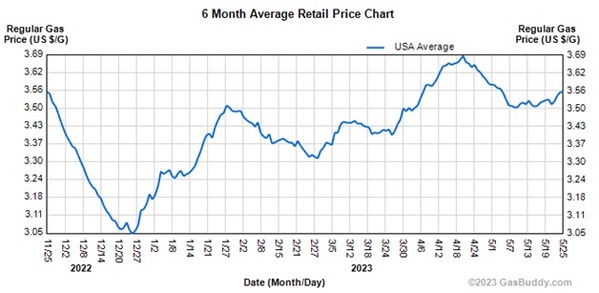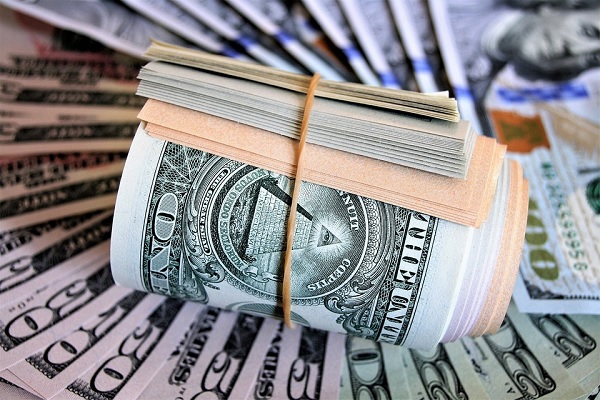
–>
May 27, 2023
It’s no secret that the lockdown-induced inflation of the last three years has pushed millions of struggling middle-class Americans to the wall. Mainstream economists, in their attempt at whitewashing this fact, insist that inflation is abating and that the U.S. economy will soon return to a relatively “normal” state by the end of the year (the estimate given by most).
‘); googletag.cmd.push(function () { googletag.display(‘div-gpt-ad-1609268089992-0’); }); document.write(”); googletag.cmd.push(function() { googletag.pubads().addEventListener(‘slotRenderEnded’, function(event) { if (event.slot.getSlotElementId() == “div-hre-Americanthinker—New-3028”) { googletag.display(“div-hre-Americanthinker—New-3028”); } }); }); }
This prediction is based in part on the recent strength of the U.S. dollar index, which many (erroneously) use to measure the greenback’s purchasing power in the everyday economy. But what the “experts” aren’t telling you is that the dollar index’s strength won’t benefit the middle class as long as there are two separate dollars at play.
Before we look into the problem, a little background will be helpful. The U.S. dollar index — which is often listed under the ticker symbol USDX — measures the value of the dollar relative to a basket of six major world currencies, including the euro and the yen. It’s weighted based on exchange rates, with most of the weighting (nearly 60%) in favor of the euro.
The world of international currencies can be arcane and confusing, but a rule of thumb to help you understand is that when a nation’s currency is persistently strengthening, it normally means the nation’s economy is also strengthening.
‘); googletag.cmd.push(function () { googletag.display(‘div-gpt-ad-1609270365559-0’); }); document.write(”); googletag.cmd.push(function() { googletag.pubads().addEventListener(‘slotRenderEnded’, function(event) { if (event.slot.getSlotElementId() == “div-hre-Americanthinker—New-3035”) { googletag.display(“div-hre-Americanthinker—New-3035”); } }); }); }
Conversely, a persistently weakening currency implies a country is undergoing inflation, which undermines the economy. For a good part of the “pandemic” years of 2020 and 2021, the U.S. dollar index was in fact weakening, reflecting the massive amounts of money-printing the Federal Reserve was engaged in (allegedly to counteract the ill effects of the lockdowns).
To the average middle-class American, the weak dollar was symptomatic of the dramatic price increases everyone was now paying — for everything from food to fuel to rent. But what the dollar index’s weakness really meant was that the U.S. economy was in peril from Washington’s shutdown orders. Consequently, with the dollar index in decline, America was no longer an attractive place for foreign investors to park their money.
Neither Washington nor Wall Street could long abide this situation, so the weak dollar problem was “fixed” during the second half of 2021. That’s when the U.S. dollar index turned around and kicked off a major rally that saw its value increase nearly 30% over a 16-month period, culminating with a multi-year peak in late 2022.
During this time of the dollar index’s improvement, American consumers noticed something: their fortunes weren’t exactly getting any better. Gas prices continued to linger near levels not seen in over a decade, while a trip to the grocery store was becoming an alarmingly painful experience.
Fast-forward to late May 2023, and the situation hasn’t improved much for the middle class, even as the dollar index is once again strengthening. This paradoxical situation raises the question: are there in fact two dollars in play — one for the “elite,” who operate in the rarified realm of corporate politics, and another dollar for the everyday American?
The answer to this question is decidedly “yes”! In fact, a stronger U.S. dollar doesn’t always mean that inflation (loosely defined here as high prices) on the retail level is diminishing. What it means is that the nation’s corporate economy and international trading position are improving.
‘); googletag.cmd.push(function () { googletag.display(‘div-gpt-ad-1609268078422-0’); }); document.write(”); googletag.cmd.push(function() { googletag.pubads().addEventListener(‘slotRenderEnded’, function(event) { if (event.slot.getSlotElementId() == “div-hre-Americanthinker—New-3027”) { googletag.display(“div-hre-Americanthinker—New-3027”); } }); }); } if (publir_show_ads) { document.write(“
For the U.S. consumer, a better measure of one’s purchasing power is found by inverting the national average of the retail gasoline price. According to GasBuddy.com, the national gas price average (as of May 25) is $3.56 per gallon. If you mentally invert the following chart of the pump price average, it will take on more of a sliding board appearance. This is what our dollar as citizens actually looks like (which I refer to as the “poor man’s dollar”).

Why the gasoline price, you ask? Because fuel prices ultimately determine the cost of a host of goods that are transported to the stores where we as consumers purchase them. And of course, it’s fuel prices, more than any single factor, that push up (or down) the cost of living for wage-earners. That means that as long as gas prices are high, living costs will also be high, which means inflation is alive and well for most Americans. And it has little, if anything, to do with the U.S. dollar index.
As for why fuel prices are so high, look no farther than Washington’s petroleum policy for the answer. Ever since the new administration was sworn in, the White House (along with other key departments) has embraced policies restricting new oil production and gasoline refining. The rationale behind those anti-oil policies is supposedly based on environment protection, but whatever the reasoning behind it, the end result is a higher cost of living for millions of Americans.
In closing, there’s a political bromide worth mentioning here: “communism always rides a wave of inflation.” That’s another way of saying the authoritarianism we’ve seen increasingly becoming normal since 2020 must be paid for on the backs of the multitude via taxes, as well as by money-printing.
And as long as the current regime is bent on ignoring the legislative process and forcing its agenda through mandates and executive orders (i.e., authoritarianism), you can bet your last “dollar” that inflation will be here for a long time to come.

Money image: pasja1000 via Pixabay, Pixabay License.
<!–
–>
<!– if(page_width_onload <= 479) { document.write("
“); googletag.cmd.push(function() { googletag.display(‘div-gpt-ad-1345489840937-4’); }); } –> If you experience technical problems, please write to [email protected]
FOLLOW US ON
<!–
–>
<!– _qoptions={ qacct:”p-9bKF-NgTuSFM6″ }; ![]() –> <!—-> <!– var addthis_share = { email_template: “new_template” } –>
–> <!—-> <!– var addthis_share = { email_template: “new_template” } –>





